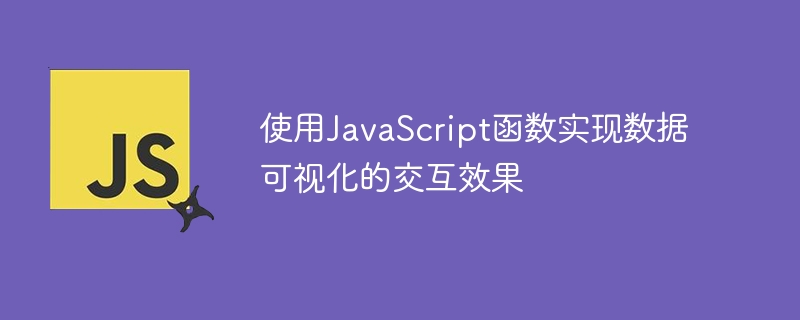

Use JavaScript functions to achieve interactive effects of data visualization
Data visualization is to display complex data in a graphical way to help people better understand the data Trends and correlations. Adding interactive effects can further enhance the user experience, allowing users to actively interact with data and explore deeper information. This article will introduce how to use JavaScript functions to achieve interactive effects in data visualization and provide specific code examples.
First, we need to prepare a chart library for data visualization. Commonly used chart libraries include Chart.js, D3.js, ECharts, etc. In this article, we will use Chart.js as an example.
Chart.js is a powerful and easy-to-use chart library that supports multiple types of charts, such as line charts, bar charts, and pie charts. At the same time, it also provides some APIs for customizing the style and interactive behavior of charts. Next, we will take a histogram as an example to show how to use JavaScript functions to achieve interactive effects in data visualization.
First, introduce the link to the Chart.js library in the HTML file:
<script src="https://cdn.jsdelivr.net/npm/chart.js"></script>
Then, add a Canvas element to the HTML file for drawing histograms:
<canvas id="myChart"></canvas>
Next, write the function to draw the histogram in the JavaScript file. First, we need to get a reference to the Canvas element:
var ctx = document.getElementById('myChart').getContext('2d');Then, we need to define the configuration options of the histogram, including chart type, data and style, etc.:
var chartOptions = {
type: 'bar',
data: {
labels: ['A', 'B', 'C', 'D', 'E'],
datasets: [{
label: 'Data',
data: [10, 20, 15, 25, 30],
backgroundColor: 'rgba(0, 123, 255, 0.5)'
}]
},
options: {
scales: {
y: {
beginAtZero: true
}
}
}
};Next, we can use Chart The API provided by .js creates a histogram object and passes in the configuration options:
var myChart = new Chart(ctx, chartOptions);
So far, we have successfully used Chart.js to draw a simple histogram. Next, we will further enrich the user experience by adding interactive effects.
First, we can provide feedback by styling the mouse on hover. Add the following code in the configuration options:
options: {
interaction: {
hover: {
mode: 'index',
intersect: false
}
},
// 省略其他选项
}In the above code, we set the interaction mode when the mouse is hovering to 'index' and disable the crosshatch. This way, when the mouse is hovered over the histogram, the value and label for that point will be displayed.
Next, we can add a click event to the histogram so that the user can click on a data point of the histogram for further operations. Add the following code to the code:
canvas.addEventListener('click', function(event) {
var activePoints = myChart.getElementsAtEventForMode(event, 'nearest', {intersect: true}, true);
if (activePoints.length > 0) {
var clickedDatasetIndex = activePoints[0].datasetIndex;
var clickedDataIndex = activePoints[0].index;
// 处理点击事件
}
});In the above code, we capture the user's click action by adding a click event listener. Then, use the Chart.js API to get the data index of the click point. Next, we can perform appropriate actions based on the index, such as displaying details or navigating to other pages.
Through the above code examples, we can see that using JavaScript functions to achieve interactive effects in data visualization is not complicated. You only need to use a suitable chart library and call the corresponding API to display interactive effects. Of course, specific interactive effects can also be expanded and optimized according to specific needs.
To summarize, using JavaScript functions to achieve interactive effects in data visualization can help users better understand and explore data. Through appropriate chart libraries and API calls, we can implement rich interactive behaviors such as mouse hover effects and click events. We hope that the content of this article can inspire readers on the interactive effect of data visualization and provide reference and help.
The above is the detailed content of Using JavaScript functions to achieve interactive effects in data visualization. For more information, please follow other related articles on the PHP Chinese website!
